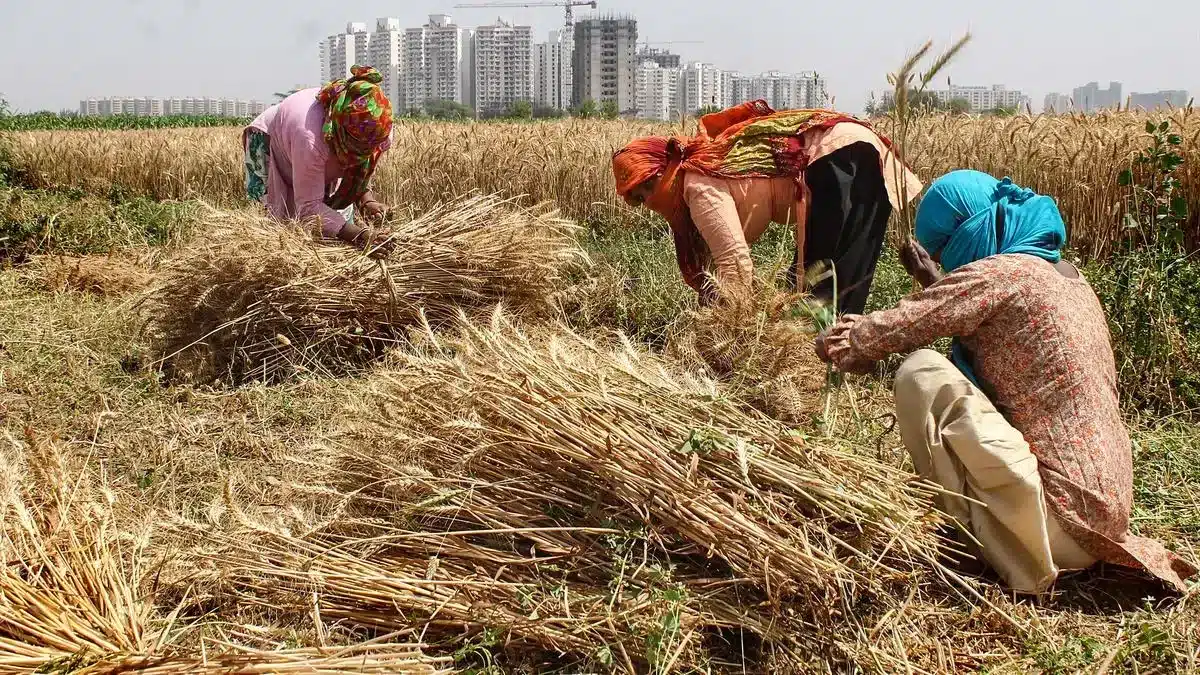What’s in today’s article?
- Why in the News?
- Problems Faced by the Agriculture Sector in India
- About NITI Aayog’s Proposal
Why in the News?
- The Central Government is considering a new scheme with an outlay of Rs 50,000 crore to incentivize states to adopt agricultural reforms.
Problems Faced by the Agriculture Sector in India
- Access to Credit & Finance:
- Small farmers struggle to get affordable loans, limiting their ability to buy modern equipment, quality seeds, and fertilizers, which affects their productivity.
- Small Landholdings:
- Many farmers have small, fragmented plots, making it hard to use modern farming techniques and reducing productivity.
- Outdated Farming Practices:
- Many farmers still use traditional methods due to limited information and resistance to change, hindering the adoption of advanced techniques.
- Water Scarcity & Irrigation:
- Dependence on monsoon rains makes agriculture vulnerable to droughts and inconsistent rainfall.
- Access to irrigation and water management is crucial, especially in areas with limited water resources.
- Soil Degradation & Erosion:
- Use of chemical fertilizers and pesticides, along with poor land use practices, degrades soil quality, leading to reduced fertility and productivity.
- Inadequate Agricultural Infrastructure:
- Lack of storage, cold chain facilities, good rural roads, and market access leads to post-harvest losses and higher production costs, limiting farmers’ ability to get fair prices.
- Market Volatility & Price Fluctuations:
- Farmers face unstable prices due to weak market links and lack of price information, making them vulnerable to exploitation and uncertain returns.
- Climate Change & Natural Disasters:
- Predictable weather, climate change, and natural disasters like floods and droughts cause crop lossesand increased risks for farmers.
- Limited Access to Technology & Research:
- Farmers have limited access to modern technologies and research, hindering the adoption of innovative practices. They need better knowledge, training, and affordable technology solutions.
- Lack of Farmers’ Empowerment:
- Farmers often lack a voice in policy-making, leading to initiatives that may not address their specific challenges effectively.
About NITI Aayog’s Proposal
- Nearly three years after repealing its three farm laws in November 2021, the Union government is planning a new scheme with a budget of Rs 50,000 crore to encourage states to adopt agricultural reforms.
- This initiative will provide central funding for states to implement reforms in agriculture marketing, contract farming, and land leasing.
- The idea for this scheme was presented by NITI Aayog officials to the Prime Minister’s Office after the NDA won its third term in the Lok Sabha elections.
- The presentation, titled “India’s Amrit Kaal: Mobilising the nation to sustain fast growth,” covered various economic sectors.
- Officials from the Ministry of Agriculture and NITI Aayog are discussing this scheme as part of their broader efforts to implement significant farm sector reforms during India’s ‘Amrit Kaal,’ a period from 2022 to 2047.
- Other reforms under consideration include passing the long-pending Seed Bill and increasing public investment in agriculture to 5% of Agriculture GVA (Gross Value Addition).
- This proposal revisits an idea suggested by the 15th Finance Commission in its 2020-21 report, which recommended performance-based incentives for states implementing agricultural reforms.
- States could receive financial rewards if they adopted the Model Agricultural Produce and Livestock Marketing Act (2017), the Model Agricultural Produce and Livestock Contract Farming Act (2018), and the Model Agricultural Land Leasing Act (2016).
- The 15th Finance Commission believed these reforms were essential to liberalize agricultural markets, promote competition, and attract private sector investment.
- However, after the central government passed the three farm laws in 2020, the Commission revised its recommendations.
- The Commission’s 2021-26 report emphasized four key areas for performance-based incentives:
- Land lease reforms,
- Sustainable water use in agriculture,
- Export promotion, and
- Contributing to Atmanirbhar Bharat.
- It had proposed Rs 45,000 crore for states undertaking agricultural reforms during this period.
While the government accepted most of the Commission’s recommendations, it stated that it would consider the identified sectors when formulating and implementing existing and new Centrally Sponsored and Central Sector Schemes.
Q1. What is the difference between Sprinkler and Drip Irrigation Systems?
While sprinkler systems consist of tubing embedded in the ground with heads above that spray water on your plants, drip irrigation has tubing that runs low along the ground and slowly drips water into the soil around your plants.
Q2. How is Groundwater recharged?
Ground water recharge includes recharge as a natural part of the hydrologic cycle and human-induced recharge, either directly through spreading basins or injection wells, or as a consequence of human activities such as irrigation and waste disposal.
Source: ToI | Govt considers Rs 50,000 crore scheme to incentivise states for agricultural reforms
Last updated on June, 2025
→ UPSC Notification 2025 was released on 22nd January 2025.
→ UPSC Prelims Result 2025 is out now for the CSE held on 25 May 2025.
→ UPSC Prelims Question Paper 2025 and Unofficial Prelims Answer Key 2025 are available now.
→ UPSC Calendar 2026 is released on 15th May, 2025.
→ The UPSC Vacancy 2025 were released 1129, out of which 979 were for UPSC CSE and remaining 150 are for UPSC IFoS.
→ UPSC Mains 2025 will be conducted on 22nd August 2025.
→ UPSC Prelims 2026 will be conducted on 24th May, 2026 & UPSC Mains 2026 will be conducted on 21st August 2026.
→ The UPSC Selection Process is of 3 stages-Prelims, Mains and Interview.
→ UPSC Result 2024 is released with latest UPSC Marksheet 2024. Check Now!
→ UPSC Toppers List 2024 is released now. Shakti Dubey is UPSC AIR 1 2024 Topper.
→ Also check Best IAS Coaching in Delhi






















